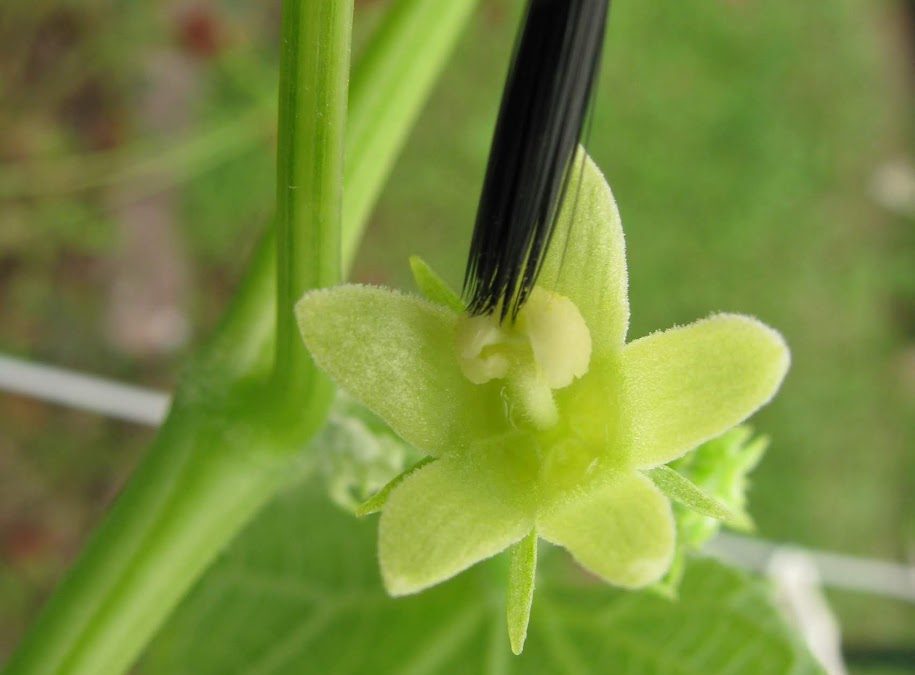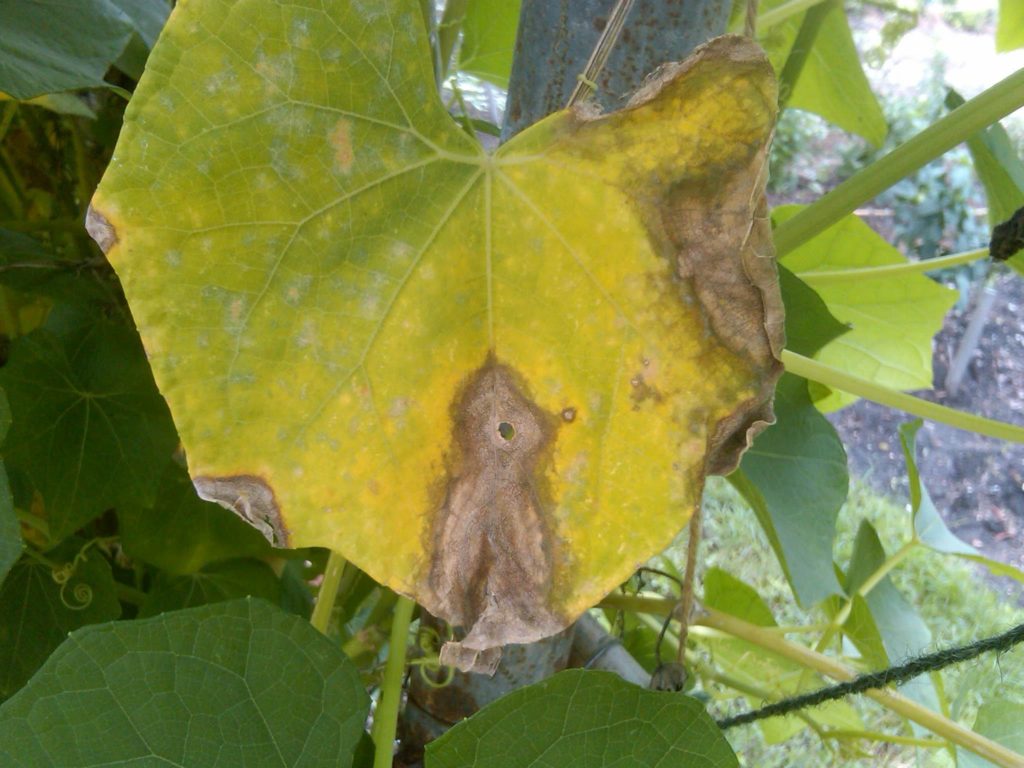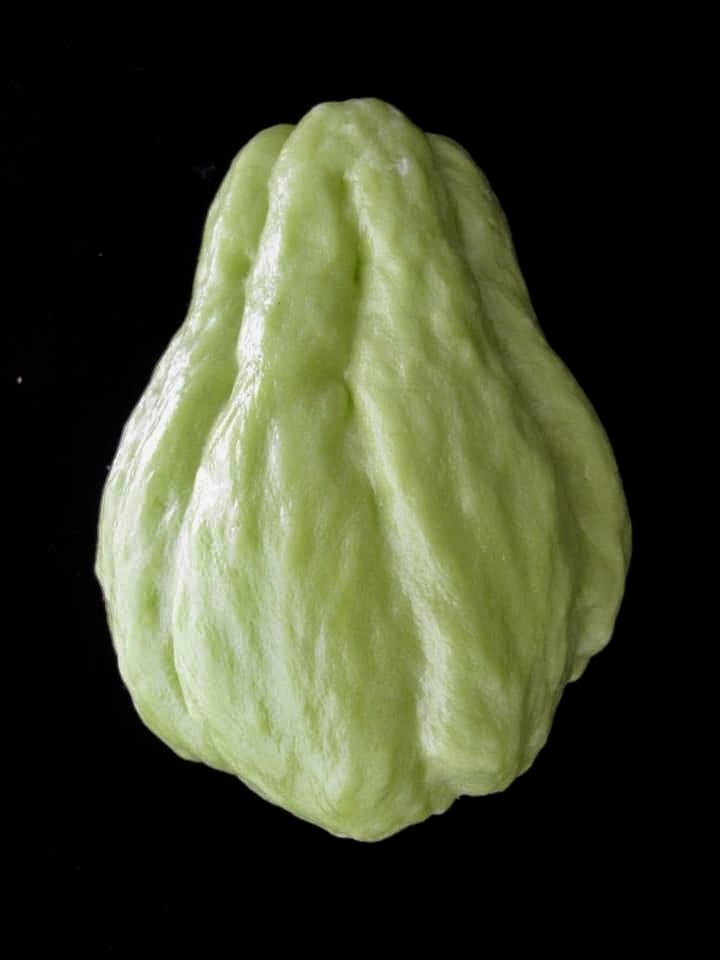
by Lance Hill | Apr 30, 2023 | How To, Mirliton
Sometimes bees and other pollinators are not doing their job and you want to ensure that your female flowers are pollinated. The simplest way is to hand pollinate with a slender artist’s brush with dark bristles. The bristles make it clear that you have collected yellow pollen from the males. Using a brush means you do not destroy the males and can return to them for additional pollen. Click on each photo in this link to read the instructions.
by Lance Hill | Apr 23, 2023 | How To

Mirliton leaf infected with anthracnose. Unlike powdery mildew which yellows uniformly and wilts the leaves, anthracnose starts as yellow wedges between the leaf veins. It then turns the leaf tissue brown and leaves with a distinctive “shot hole.”
Anthracnose is a summer disease caused by many fungi, but the pathogen that affects mirlitons is Colletotrichum lagenarium. For the purposes of this article, I will call Colletotrichum lagenarium the “anthracnose fungus. It is a chronic problem with mirlitons and it’s the main reason plants die the first year. There is no known synthetic or biological fungicide that can prevent or eradicate anthracnose in mirlitons. But anthracnose is like a sprained ankle; you can’t prevent it or take a pill to cure it, but you can minimize the risk of getting it and speed up the healing process.
Anthracnose and powdery mildew (PM) are fungal diseases that start with a common sign; leaf yellowing (chlorosis). It’s important to recognize the difference because powdery mildew can be treated, while anthracnose can’t. The PM fungus spreads on the surface of leaves, initially as faded yellow dots and then yellowing the whole leaf until it wilts and dies. Anthracnose, in contrast, grows inside the leaf cells and spreads cell-to-cell (intercellularly)l, so it tends to spread between the leaf veins and form sharp wedges. It kills the tissue within the wedge spreading across to the whole leaf, so you will see both yellow and brown tissue in the same wedge photo.
Mirlitons tend to experience anthracnose epidemics in July and August because of rain patterns. Intensive rains splash up anthracnose fungi from the ground onto the plant stem. The fungus incubates during warm nights and produces thousands of spores that are contained in a sticky base. Rainstorms dissolve the sticky film which releases the spores. Then, raindrops splash the spores to adjacent leaves–and that’s why anthracnose epidemics occur during the hot rainy season.
Anthracnose infects every part of the vine, including leaves, petioles, and stems. It will eventually split the stem, preventing the flow of nutrients to the ends of the stem, so suddenly a whole section of the vine will wilt and die. The good news is that for every stem lost, a healthy vine will send up a new shoot. It is a tug-of-war with the disease through the summer, but generally, the disease will disappear by September in time for flowering and fruiting.
The key to surviving an anthracnose epidemic is to have a healthy vine in place before the epidemic. That means a well-drained and aerated vine. When the soil is water-saturated and no oxygen is available in the root zone, plants go through dramatic changes to survive. They are literally in “anoxic” soil like the dead zones in the Gulf of Mexico. They shift from aerobic metabolism to anaerobic metabolism: they have only 5% of the energy efficiency they have in healthy aerated soil; they produce toxic organic and inorganic compounds, and they deprive leaves of potassium crucial to maintaining leaf functions. After 24-48 hours, the roots have been damaged making it more difficult for them to uptake water and nutrients. Leaf functions are weakened and the whole plant is vulnerable to disease.
The good news is that a mirliton will acquire increased resistance to anthracnose every time it gets the disease. If your vine gets anthracnose this year, it is less likely to get it next year.
The solutions are simple.
Ground Planting:
Make sure the soil is well-drained and aerated. Plant on your highest area available, use planting hills, and stay away from roofs. Plant near a tree if you have one; trees are natural sponges and tend to stabilize soil moisture. If you already have the vine planted, you can dig shallow drainage trenches to remove excess rainfall away from the vine or add a corrugated drain pipe or a French drain.
Raised-bed Planting:
Remember that a raised bed can’t drain into a saturated yard, so you need to construct a bed that will permit excess rainfall to escape the bed via the sides. Add a lateral route for excess water to exit above ground level by drilling 1/4 “ holes along the side panels.
Summary:
For now, the best protection against anthracnose is (1) to use only locally grown heirloom mirlitons for seed since they are likely to have some resistance to anthracnose; (2) plant in well-drained, aerated sites; (3) provide plenty of trellis space so leaves on top can spread out and get maximum exposure to the sun (a natural fungicide) and air circulation; (4) minimize leaf/soil contact by using an overhead horizontal trellis at least 4 feet above the soil and (5) always irrigate gently with a hose set on low on the surface or drip irrigation to prevent splash-up of soil-borne fungi. Do not water mirlitons from the top down. Once leaves and stems are brown and dead, remove them and dispose of them away from the vine.
Click here to see photos of anthracnose infection signs on leaves and stem at different stages (click on each photo for descriptions)
Click here for how to identify and manage powdery mildew.
by Lance Hill | Apr 9, 2023 | How To, Mirliton

Up until about 2020, any mirliton grown in Louisiana was an heirloom mirliton. They were what botanists call a “landrace.” Landraces are domesticated plants that developed over time and adapted to their natural environment and are not the product of human manipulation–such as plant breeding or modern genetic science. Haitians brought the first mirlitons to Louisiana over two centuries ago and that landrace thrived because it was adapted to our altitude, climate, pests, and diseases.
The mirliton landrace is easy to recognize because of its distinctive fruit traits; they are large, slightly pear or egg-shaped, with smooth skin, longitudinal furrows (though a few may be unfurrowed), and either green or white. Over the years other varieties were introduced from Mexico and Central America and interbred with the Louisana landrace. The resulting landrace was what generations of Lousianians simply called “mirlitons.” And for most of the last two centuries, there was only one variety.
Then things changed. After Hurricane Katrina wiped out almost all mirlitons in New Orleans, garden experts advised me to buy any chayote (mirliton) from a grocery store and plant it. That didn’t work because almost all imported chayote grew at high altitudes and would not produce in Louisiana. So I began to search for growers of our Louisiana landrace to replace the New Orleans ones. I soon found many growers in rural areas and when I did, I would name the mirliton after the grower so that we could track and preserve it.
I eventually noticed differences within Louisana mirlitons–there were clearly different subvarieties in the landrace. Mirlitons were more complex than we thought. Since the Louisiana mirliton has never been genetically analyzed, I decided to classify the subvarieties by fruit appearance (morphology), and then interview the growers to determine the strain’s history. If I could establish that the mirliton had been continuously grown for at least two decades, then I named it after the grower. That way we could keep that particular line going. That’s how named varieties came to be.
So there are two categories of Louisiana mirlitons:
1. Unnamed Louisiana Mirlitons is the name for the traditional Louisiana landrace. That encompasses almost any mirliton that was locally grown in Louisiana. We call these “unnamed variety.”
2. Named Certified Louisiana Mirlitons are the few strains within the larger unnamed category that Mirliton.Org has named after investigating and verifying they have been continuously grown for at least twenty years in Louisana. There are currently thirteen named certified varieties of Louisiana heirloom mirlitons:
Ervin Crawford
Joseph Boudreaux
Ishreal Thibodeaux
Boudreaux-Robert
Jody Coyne
Blacklege
Papa Sylvest
Bogalusa whites
Chauvin-Rister
Remondet-Perque
Miss Clara
Bebe Leblanc
Maurin
Only these named certified varieties have been researched and verified as authentic heirlooms. If you grow one of these named varieties, you can be confident you are growing a Louisiana heirloom.
Why is it important to continue tracking heirlooms? Beginning in 2020, several grocery store chains began to import chayote (mirlitons) that looked exactly like our heirloom varieties because they sold better. And some people began to grow them because they were indistinguishable from our heirloom variety. The problem is that imported chayote may carry a deadly seed-transmissible virus that can destroy the Louisiana variety. It’s called Chayote Mosaic Virus (ChMV), and it’s devastated crops in other countries.
If you want to preserve the Louisiana heirloom variety and keep them safe, the best way is to only use certified heirloom seeds like the ones named above. Mirliton.Org offers a free certification service and maintains a list of certified growers.
We can also certify new varieties that you may come across–and we expect the list of verified ones to grow. If you find a grower who says that their mirlitons were locally grown but have no name, the grower can ask Mirliton.Org to verify and certify them as an heirloom variety. We will do that by examining fruit characteristics, taking an oral history, and conducting visits to grow sites.
by Lance Hill | Apr 1, 2023 | How To, Mirliton

Growers normally try to delay mirliton sprouting by putting new fruit in paper bags and storing them in a cool part of the house. Cool temperatures promote dormancy and prevent sprouting. That’s good in the winter, but in the spring, you will want to get them quickly sprouted so they can be directly planted. Here’s an “incubation” trick that Joseph Boudreaux of Broussard taught me that speeds up sprouting.
You can incubate them inside your home using a small plastic trash can with a heating pad underneath. Place the mirlitons in the can and loosely cover the top with some cardboard. Place a thermometer next to the mirlitons and adjust the heating pad to maintain the can temperature at 80°-85°. When kept warm like this, the fruit will normally begin to sprout within 10-14 days. Sprouting is defined as when the internal seed pushes its way to the large end of the seed (“sticks its tongue out) and a small green shoot emerges. Here is how I did it with a trash can.
If the outside temperatures are in the 90s, you can do this outside in a cardboard box without a heating pad. Once you pick the fruit, place it in a shaded warm area with a constant temperature of at least 75-80°F to encourage sprouting. If storing them outside, use chicken wire or netting to protect the seed from pests that enjoy eating the new sprouts.
Once a mirliton sprouts, it means the seed is viable and can be planted. It’s important not to distribute or sell the seed until it has sprouted because sometimes—especially with Spring mirlitons—the seed can look healthy but have no internal inner seed and will not sprout and grow a new vine (it’s called parthenocarpy).




Recent Comments